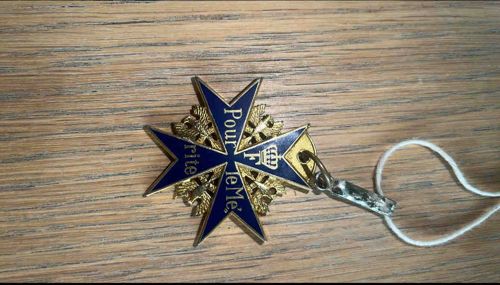
Pour le Mérite Medal (Blue Max)
The item is a medal, specifically resembling the Prussian Pour le Mérite (Blue Max) military order. It features a Maltese cross design with four arms, each enameled in a deep blue color with gold-colored edges. The central part of the cross arms, where they meet, is adorned with intricate gold-colored filigree or scrollwork, which appears to be a separate overlay or meticulously cast detail beneath the blue enamel. The lettering "Pour le Mérite" is inscribed in gold in the spaces between the cross arms, with "Pour" on the top left, "le Me." on the top right, and "rite" on the bottom left. The bottom right arm of the cross shows what appears to be a crowned 'F' monogram, likely representing King Frederick the Great. The overall construction suggests a metal base, possibly gilded brass or bronze, judging by the gold-colored elements. The enamel appears largely intact with a smooth, glossy finish, though closer inspection might reveal minor surface scratches or dust. The reverse side is not visible, but would typically also be enameled in blue. The medal is attached via a small gold-colored loop to a clip mechanism, which is then connected to a plain white string or cord. This clip and string assembly appears to be a contemporary addition, possibly for display or handling purposes, and does not seem original to the medal itself. The metal of the clip shows some wear or oxidation, appearing dull and slightly discolored. The medal itself exhibits good craftsmanship, with crisp lines and vibrant enamel, indicating it was likely produced with attention to detail. Given its historical significance, the condition of the enamel and metalwork is crucial for valuation. While wear and tear are minimal based on the visible side, the patina on the metal elements, particularly the gold-colored parts, suggests some age. This style of medal dates back to the 18th century, with significant production during the 19th and early 20th centuries, particularly during World War I.
AI-Generated Appraisal Disclaimer
Estimated Value
Undetermined; due to unverified authenticity
Basic Information
Category
Military Order/Medal
Appraised On
November 28, 2025
Estimated Value
Undetermined; due to unverified authenticity
Additional Details Provided By Owner
User Provided Information
The missing pour le merite that disappeared from Germany that is said to be owned by Noah Dohme that is the emperor of lixland which is 75 million square kilometers owned by Noah Dohme the emperor of lixland which is 18 years old
Item Description
The item is a medal, specifically resembling the Prussian Pour le Mérite (Blue Max) military order. It features a Maltese cross design with four arms, each enameled in a deep blue color with gold-colored edges. The central part of the cross arms, where they meet, is adorned with intricate gold-colored filigree or scrollwork, which appears to be a separate overlay or meticulously cast detail beneath the blue enamel. The lettering "Pour le Mérite" is inscribed in gold in the spaces between the cross arms, with "Pour" on the top left, "le Me." on the top right, and "rite" on the bottom left. The bottom right arm of the cross shows what appears to be a crowned 'F' monogram, likely representing King Frederick the Great. The overall construction suggests a metal base, possibly gilded brass or bronze, judging by the gold-colored elements. The enamel appears largely intact with a smooth, glossy finish, though closer inspection might reveal minor surface scratches or dust. The reverse side is not visible, but would typically also be enameled in blue. The medal is attached via a small gold-colored loop to a clip mechanism, which is then connected to a plain white string or cord. This clip and string assembly appears to be a contemporary addition, possibly for display or handling purposes, and does not seem original to the medal itself. The metal of the clip shows some wear or oxidation, appearing dull and slightly discolored. The medal itself exhibits good craftsmanship, with crisp lines and vibrant enamel, indicating it was likely produced with attention to detail. Given its historical significance, the condition of the enamel and metalwork is crucial for valuation. While wear and tear are minimal based on the visible side, the patina on the metal elements, particularly the gold-colored parts, suggests some age. This style of medal dates back to the 18th century, with significant production during the 19th and early 20th centuries, particularly during World War I.
Get Your Items Appraised
Instant estimates of your treasures with AI-powered instant appraisals